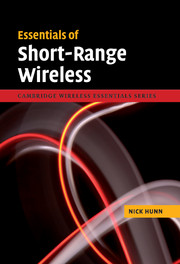Book contents
- Frontmatter
- Contents
- 1 Introduction
- 2 Fundamentals of short-range wireless
- 3 Wireless security
- 4 Bluetooth
- 5 IEEE 802.11abgn/Wi-Fi
- 6 IEEE 802.15.4, ZigBee PRO, RF4CE, 6LoWPAN and WirelessHART
- 7 Bluetooth low energy (formerly Wibree)
- 8 Application development – configuration
- 9 Application development – performance
- 10 Practical considerations – production, certification and IP
- 11 Implementation choices
- 12 Markets and applications
- Glossary of acronyms and abbreviations
- Index
- References
10 - Practical considerations – production, certification and IP
Published online by Cambridge University Press: 10 November 2010
- Frontmatter
- Contents
- 1 Introduction
- 2 Fundamentals of short-range wireless
- 3 Wireless security
- 4 Bluetooth
- 5 IEEE 802.11abgn/Wi-Fi
- 6 IEEE 802.15.4, ZigBee PRO, RF4CE, 6LoWPAN and WirelessHART
- 7 Bluetooth low energy (formerly Wibree)
- 8 Application development – configuration
- 9 Application development – performance
- 10 Practical considerations – production, certification and IP
- 11 Implementation choices
- 12 Markets and applications
- Glossary of acronyms and abbreviations
- Index
- References
Summary
Many designers rush into wireless without any knowledge or consideration of the practical issues they will face in manufacturing and selling a wireless product. Wireless introduces a number of requirements over and above those of normal electronics design. These need to be understood if manufacturers wish to place their products on the market and conform to legal requirements.
This chapter highlights these areas, so that a designer can assess the most practical route when embarking on a wireless design. If they are ignored, (as they frequently are), the resulting cost in putting things right after the event can be greater than the cost of the rest of the design effort. In the worst case, a national regulator can stop shipment of products within its country.
10.1 Regulatory approval
To the best of my knowledge, it is legal to sell a cable anywhere in the world. Plugging in a cable doesn't generate any significant amount of electromagnetic radiation that could interfere with other products. Replace that cable with a radio transmitter and everything changes.
Although we are talking about radios that work in the unlicensed ISM bands, that does not grant designers a right of laissez-faire. Products still need to adhere to strict rules and manufacturers must be able to prove that they meet them. These rules exist to try to ensure open access to anyone who wants to use that spectrum, minimising the possibility and severity of interference and to prevent any single product from monopolising too much of the spectrum.
- Type
- Chapter
- Information
- Essentials of Short-Range Wireless , pp. 264 - 283Publisher: Cambridge University PressPrint publication year: 2010

